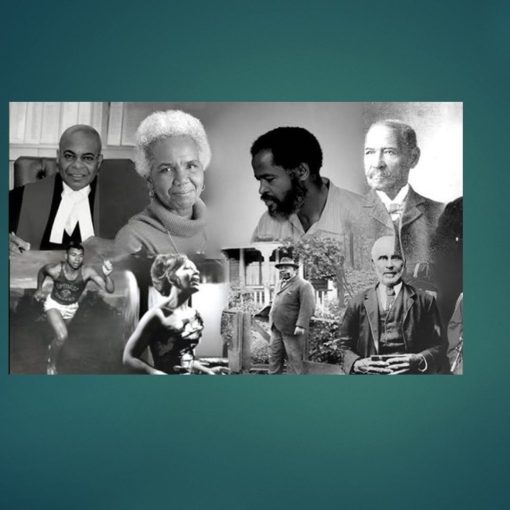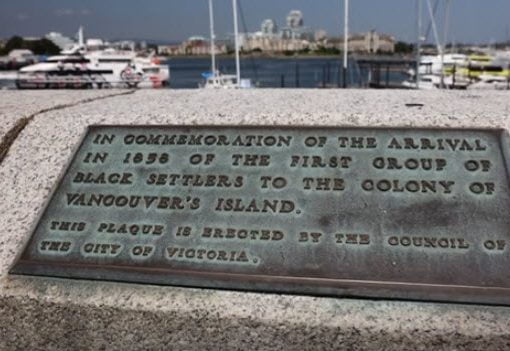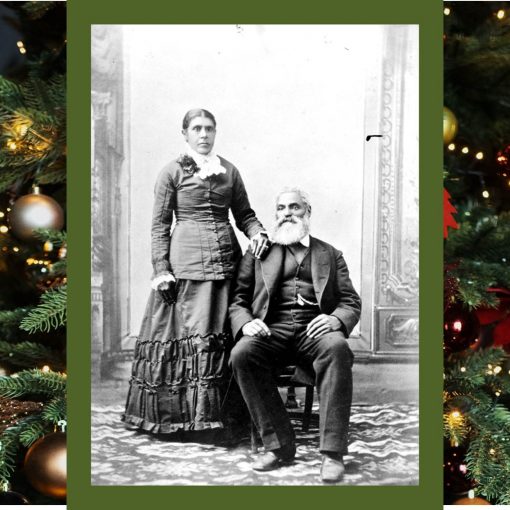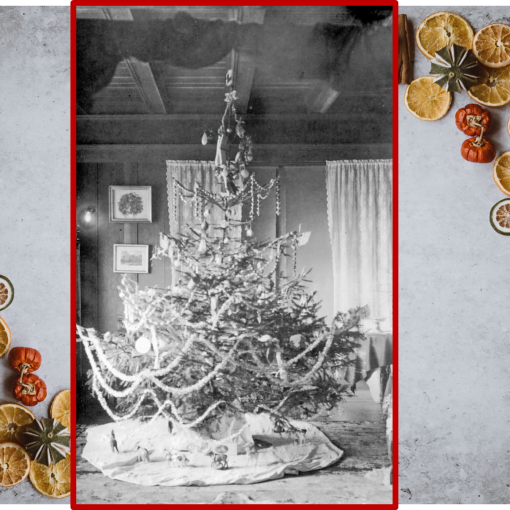By the spring of 1860 40 to 50 Black men were enrolled in the Victoria Pioneer Rifle Corps. The Corps was officially sworn in on July 4, 1861.
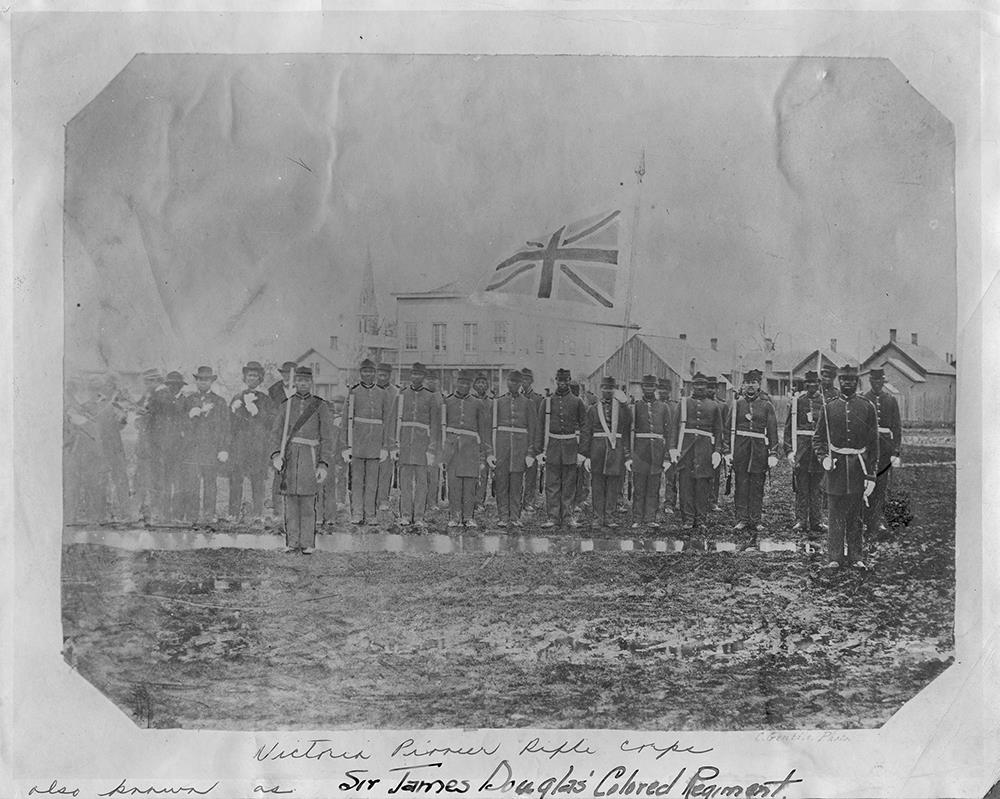
In 1859, when the volunteer Fire Department was being created in Victoria, several Black men volunteered to serve but they were rejected by the white men organizing the committee. Undaunted, they met with Governor Douglas to offer their services as a volunteer militia unit. In view of a potential war between the United States and Canada over ownership of the San Juan Islands, Douglas accepted. This conflict became known as “The Pig War” named for an American settler who shot a pig belonging to a British farmer.
Consisting of one captain, three officers and forty-four privates, the VRPC drilled twice a week. The Royal Navy supplied drill sergeants. The volunteers raised the funds to build their own drill hall on Yates Street; it was later moved/reconstructed on View Street between Quadra and Blanshard Streets. Sometimes, it is noted, they paraded on the “commons”, a ten acre piece of land on Church Hill.
Some known members of the corps were: Edward A. Booth (Paymaster), William Brown, Randel Caesar (Sergeant), Paris Carter (Captain), Abner Hunt Frances, J.B. Johnson (2nd Lieutenant), Richard H. Johnson (Captain), Adolphus C. Richards (Secretary), Fortune Richards (Captain), Solomon Stevens (Corporal), and Richard Stokes, Private. The officers were elected from time-to-time.
The company is said to have had the first military band on Vancouver Island. It consisted of nine instruments and was led by a white bandmaster who was hired to teach them music. Band members can be seen on the left of the photo.
In the beginning, their weapons were antique flintlocks supplied by the Hudson's Bay Company. Douglas was to procure better weapons from England but none ever reached the Black Militia. Through its entire existence the Victoria Pioneer Rifle Corps was in need of financial support, but that support was minimal and at times requests for monetary assistance went unheeded.
For the most part funds were raised through subscriptions or other fund-raising projects from within the Black community itself; the drill house became a popular gathering place and social centre for the Black community.
Despite the early reception of the Black Militia, the corps seemed to have met less than ongoing recognition from Governor James Douglas. Appeals for rifles and funding were still unavailable to them and the unit was largely inactive during 1863.
But the Black community remained faithful; on March 14, 1864 a ceremony was held to present the British Flag. The full transcript is at the end of this article.
“Yesterday afternoon numbers of people assembled at the Pioneer Hall on View Street, to witness the presentation of a pair of colours to the above corps by its lady friends. The ceremony took place at 1:30 when the corps having been formed two deep in the open space adjoining the Hall. Miss Sarah Pointer came forward, and the colours, which were handsomely embroidered, having been laid across the drum, read the following address in a clear, distinct voice: “Captain and members of the Victoria Pioneer Rifle Company, on behalf of the Ladies of Victoria, I present to you this flag. … “
Immediately after this auspicious occasion, the Corps experienced publicly the “unnecessary humiliation” that Captain Johnson spoke of at the presentation of colours ceremony. 11 days later, on March 25th the new Governor Arthur Kennedy arrived. The Corps was not invited to attend Douglas’s farewell banquet and when the new Governor was sworn in, the Corps was refused entry to the ceremonies because other groups would not march behind them.
Shortly after the new governor's arrival, the VPRC marched to the Legislative Buildings to present an address of loyalty to the governor in which they made reference to the discrimination against them. Kennedy informed them he would try to breach the rift between whites and blacks, but nothing was done; in fact Kennedy recommended that they should disband.
By the spring of 1865, the unit had virtually disbanded in disgust. Johnson, wrote a letter to the Editor of the Colonist newspaper, May 9, 1865 stating, “...their enthusiasm and ardour as far as this colony is concerned have evaporated. This mean and scandalous manner in which they were treated upon the advent of Governor Kennedy is still fresh in their minds. Having as much human nature under their dark skins as others of a paler hue, they cannot forget the snubbing they received on that occasion...”
In about 1868, their drill hall was taken over by Willis Bond, general contractor and auctioneer. Bond owned the property until his death in 1892.
The lives of these courageous men are unfortunately, largely unknown. We believe, that like many other 1858 in-comers, they returned to the United States after the American Civil War ended in 1865. However, three soldiers, Edward A Booth, Paymaster, Captain Paris Carter and Private Richard Stokes are buried at Ross Bay Cemetery. Abner Hunt Francis is buried at Pioneer Square on Quadra Street.
The grave markers for Edward Booth, Paymaster, Private Richard Stokes and Captain Paris Carter [1820-1890], and his wife Mary were funded and installed through the efforts of the Last Post Fund (LPF). The LPF mission is to ensure that no Veteran is denied a dignified funeral and burial, as well as a military gravestone, due to insufficient funds at the time of death. Through their Unmarked Graves Program, they provide a permanent military marker for eligible Veterans who lie in unmarked graves.
Edward A. Booth, Paymaster was among the first group of Blacks who arrived in 1858 and in September 1858 he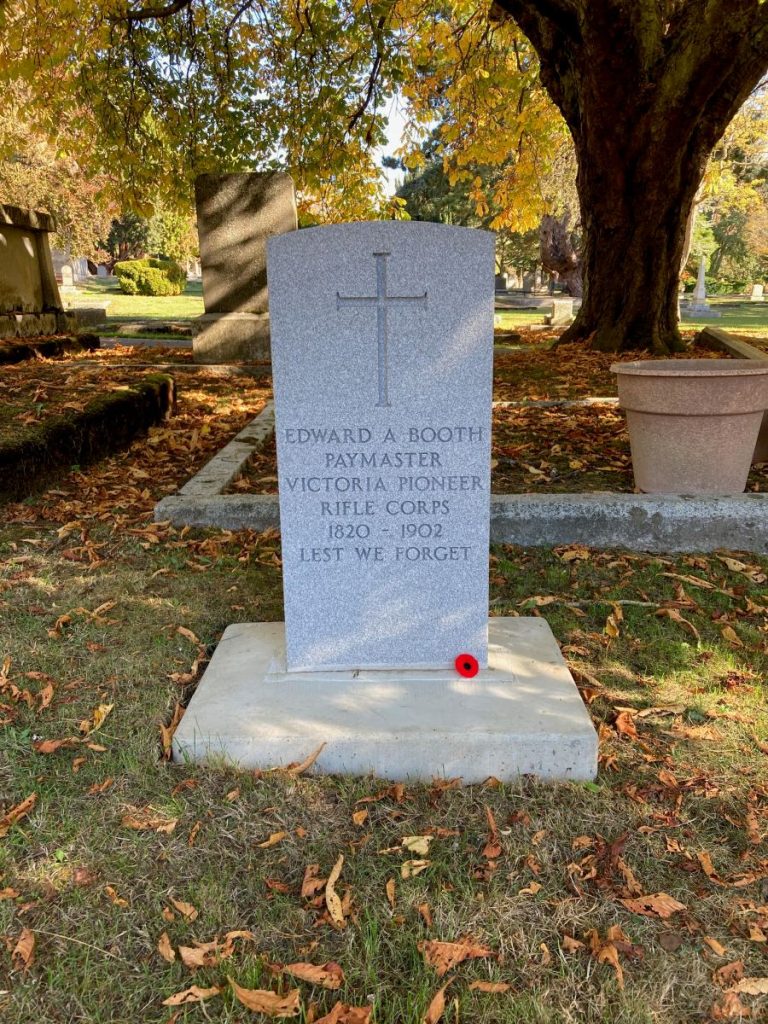 was one of 53 men who applied for citizenship; listing his occupation as water carrier. In the 1860 First Victoria Directory he is living on Fort Street. He is one of the original members of the VPRC. After the VPRC disbanded, Booth remained in Victoria – in the 1871 Directory, he still resides on Fort Street, listing his occupation as a Teamster.
was one of 53 men who applied for citizenship; listing his occupation as water carrier. In the 1860 First Victoria Directory he is living on Fort Street. He is one of the original members of the VPRC. After the VPRC disbanded, Booth remained in Victoria – in the 1871 Directory, he still resides on Fort Street, listing his occupation as a Teamster.
Edward Booth died in January 1902. His death notice in the British Colonist on January 18th says that his funeral took place at his brother’s home, 187 Johnson Street. According to the Victoria City District, 187 Johnson Street was the home of Samuel Booth, who was a noted miner and prospector. Two of Edward Booth’s pallbearers were John Giscombe and Stacy Cooness, they had also spent many years exploring and mining in northern BC. Samuel Booth, and other Booth family member grave markers were part of our Gravesite Conservation and Restoration Project in 2023/2024.
Paris Carter, Captain and his wife Mary.
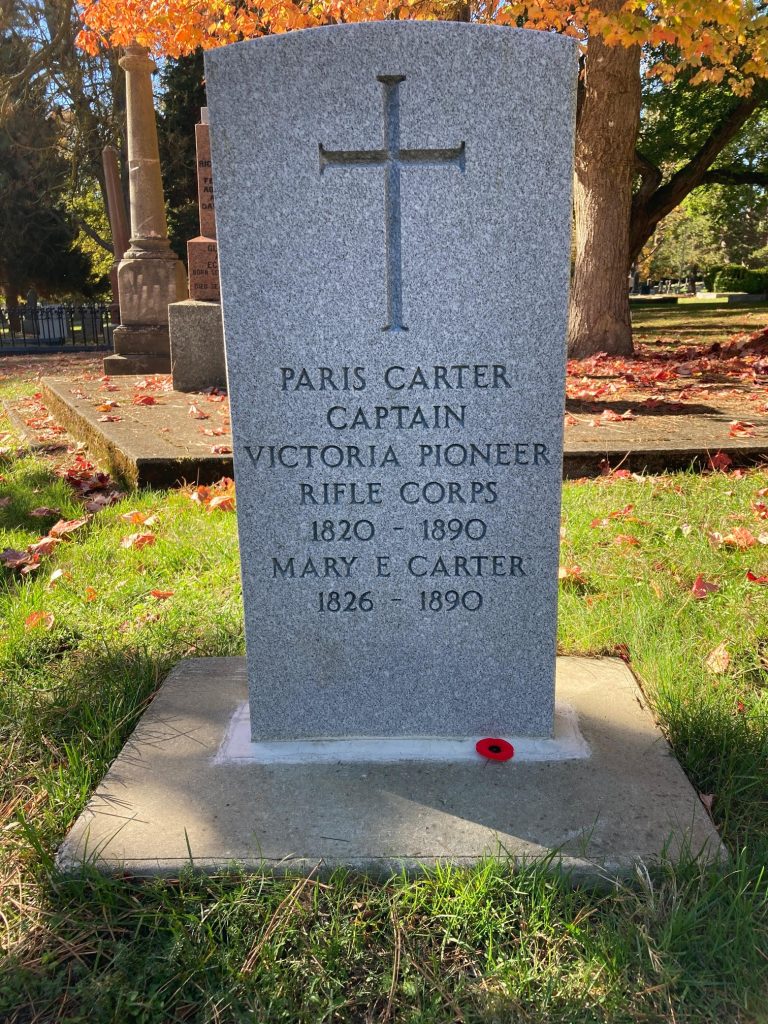 Paris Carter advertised regularly in the Colonist as a “General Agent, Collector of Rents and Debts” with an office on View Street; and he was also referred to as a real estate agent. A remembrance for Paris Carter in the Times Colonist on November 4, 1890 (pg.5) “One Less” “Another friendly, familiar face is missing, today, from those which, from long association, have come to be regarded almost as part of the province.
Paris Carter advertised regularly in the Colonist as a “General Agent, Collector of Rents and Debts” with an office on View Street; and he was also referred to as a real estate agent. A remembrance for Paris Carter in the Times Colonist on November 4, 1890 (pg.5) “One Less” “Another friendly, familiar face is missing, today, from those which, from long association, have come to be regarded almost as part of the province.
The deceased was a native of the Sunny South, and came to Victoria in ‘58 and opened a real estate office on View Street, in this booming town. For a time, business was good, and then came a long period of depression, followed by a renewed prosperity, so that Mr. Carter experienced the ups and downs that came to the city which he made his home for the past 25 years.
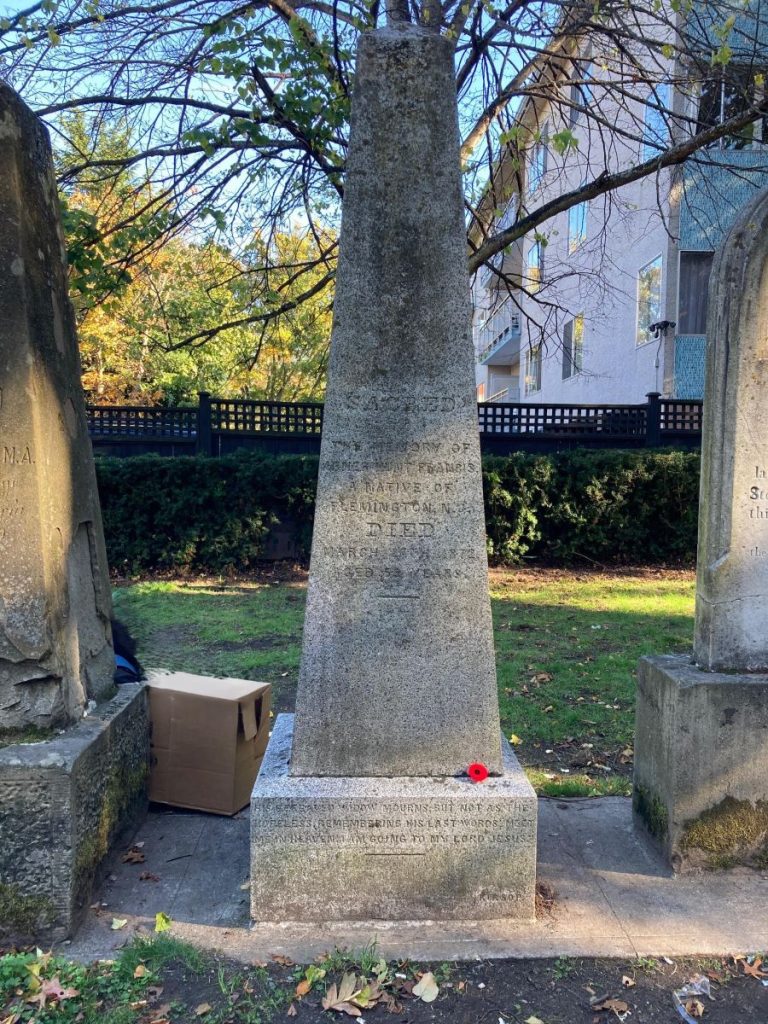 Abner Hunt Francis was born in New Jersey. He was active across the United States as an abolitionist and activist; he attended national Black conventions and was active in the struggles to secure voting rights for all men. He arrived in Victoria with his wife Sydna and daughter Theodosia in 1860. Francis was active with the VPRC from its early beginnings. He was also prominent in Victoria politics and various business ventures. On March 27, 1872 Abner Hunt Francis died. There was a notice in the British Colonist the next day. “Death of Mr. A.H. Francis. Mr. Abner Hunt Francis, a leading and influential colored resident, died quite suddenly yesterday.” The obelisk headstone was paid for by his wife, Sydna.
Abner Hunt Francis was born in New Jersey. He was active across the United States as an abolitionist and activist; he attended national Black conventions and was active in the struggles to secure voting rights for all men. He arrived in Victoria with his wife Sydna and daughter Theodosia in 1860. Francis was active with the VPRC from its early beginnings. He was also prominent in Victoria politics and various business ventures. On March 27, 1872 Abner Hunt Francis died. There was a notice in the British Colonist the next day. “Death of Mr. A.H. Francis. Mr. Abner Hunt Francis, a leading and influential colored resident, died quite suddenly yesterday.” The obelisk headstone was paid for by his wife, Sydna.
On the base of Abner Hunt’s marker are these words “HIS BEREAVED WIDOW MOURNS, BUT NOT AS THE HOPELESS, REMEMBERING HIS LAST WORDS – “MEET ME IN HEAVEN. I AM GOING TO MY LORD JESUS.”
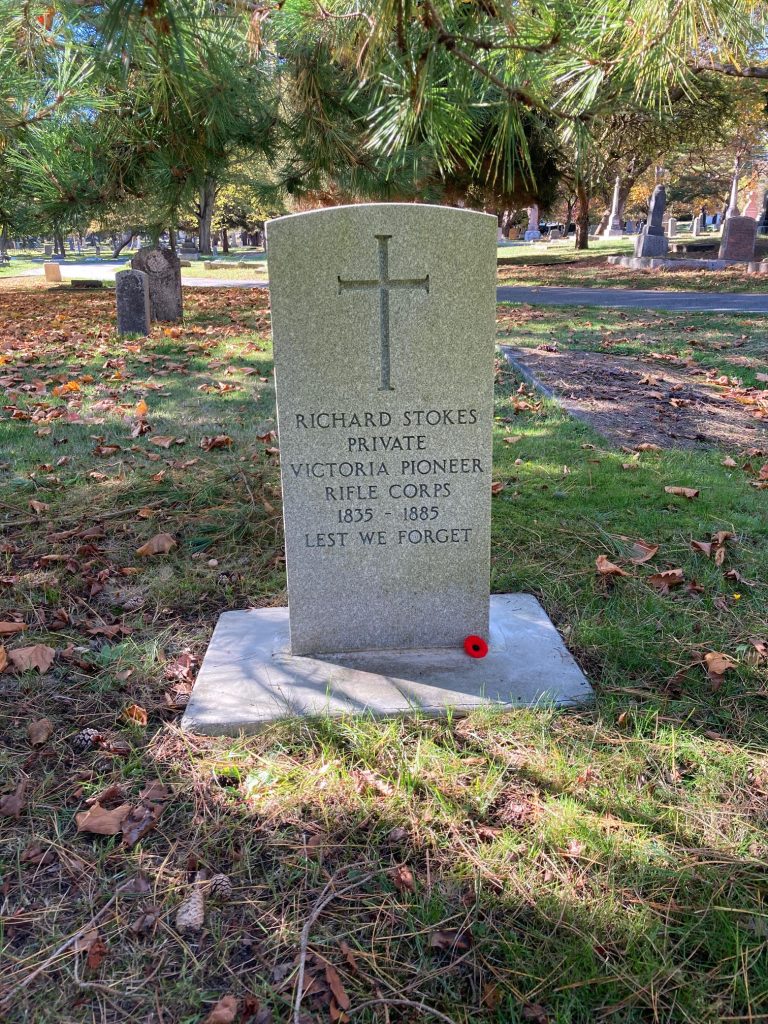 Richard Stokes, Private was also among the first group of Black pioneers who arrived in 1858. Like Edward Booth, in September 1858 he was one of 53 men who applied for citizenship. Born in Virginia, about 1835, he listed his occupation as “carrier”. He then owned and operated a livery stable on Broughton Street near Blanshard for many years. In the 1881 Canadian/BC Census he is listed as living in the James Bay Ward. It seems he remained a bachelor.
Richard Stokes, Private was also among the first group of Black pioneers who arrived in 1858. Like Edward Booth, in September 1858 he was one of 53 men who applied for citizenship. Born in Virginia, about 1835, he listed his occupation as “carrier”. He then owned and operated a livery stable on Broughton Street near Blanshard for many years. In the 1881 Canadian/BC Census he is listed as living in the James Bay Ward. It seems he remained a bachelor.
He died on May 16th, 1885, about 50 years old. The next day, on May 17th, 1885 a notice of his death was published in the Times Colonist. “Pioneer – Richard Stokes, in 1858, and for many years subsequently, a prominent citizen, died yesterday after a long illness.
***** Transcript “Presentation of Colours to the Pioneer Rifle Corps”
“Yesterday afternoon numbers of people assembled at the Pioneer Hall on View Street, to witness the presentation of a pair of colours to the above corps by its lady friends. The ceremony took place at 1:30 when the corps having been formed two deep in the open space adjoining the Hall. Miss Sarah Pointer came forward, and the colours, which were handsomely embroidered, having been laid across the drum, read the following address in a clear, distinct voice: -
“Captain and members of the Victoria Pioneer Rifle Company, on behalf of the Ladies of Victoria, I present to you this flag. It affords as much pleasure so to do as we know your loyalty to the government is proverbial. The fostering care it has shown to the oppressed of our race, leaves us under many obligations to the sagacity and wisdom of her statesmen.
Yet it is this far distant Colony of Her Majesty’s dominion we have many causes to complain. True you have not as yet been called on to rally under the flag for its protection; yet the war of complexional distinction is upon us, and is more ravaging to us as a people than that of Mars.
But men, as long as this flag shall wave over you, you may rest assured that no man, or set of men, or nations, can successfully grind you down under the iron heel of oppression. Then soldiers, look to this insight of liberty that has waved a thousand years over the battle and the breeze. In committing this colour to your charge, we only hope that you will guard it well, and yourselves be untarnished as the color. It will inspire you in the hour of peril; it is a nation’s proudest boast; “it’s terror to a foe and a canopy of peace to freeman”.
At the conclusion of the address, Captain Johnson advanced and sinking on one knee received the colours from Miss Pointer. He then turned and having delivered them to the colour sergeants, made a very able and telling reply.
He thanked the ladies for their gift and intimated that had it not been for the interest always manifested by the ladies in the welfare of the corps, it must have died out long ago. He then went on to speak of the reasons which had induced the colored people to migrate here saying that they had been ill used in America, and had come to a British Colony to find that freedom and justice which had been before denied them, but which they knew to be the boast and the glory of all England’s possessions.
He expressed regret at the course taken by a portion of the community here, in endeavoring to subject his race to unnecessary humiliation, and in attempting to debar them from the enjoyment of the rights freely accorded to all other citizens.
But he said the colored people were and ever would be, leal and loyal citizens to England’s Queen, and if ever it should become necessary, the corps which he had the honour to command would be ready and prompt to defend the flag, “the flag that’s braved a thousand years the battle and the breeze.”
--------------------------------------------
Sources:
A Catalogue of Information and Sources of Information Pertaining to Blacks in British Columbia
“Presentation of Colours” Article, Chronicle, March 15, 1864
“Pioneer Rifle Company” Letter to the Editor, Colonist, May 9, 1865, Page 2
City of Victoria Archives – Real Estate Assessment Rolls
Historic Sites and Monuments Board of Canada
Images:
Corps standing in their ranks F-00641, Courtesy of Royal BC Museum and Archives
Grave markers for Edward Booth, Paris Carter, Abner Hunt Francs, and Richard Stokes - Courtesy of BC Black History Awareness Society

